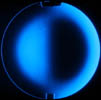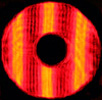January 25, 2015: Phase Shifting Interferometry
All text and images Copyright Michael E. Lockwood, all rights reserved.
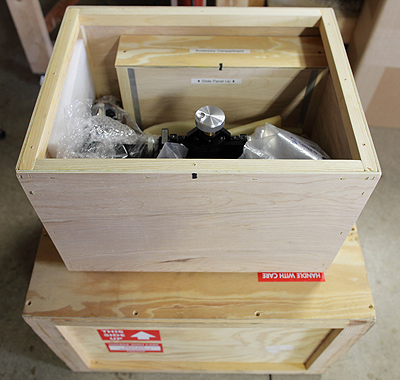 I
am pleased to announce that Lockwood Custom Optics, Inc., as acquired a
new Buccini MIC-1 interferometer, and it has been upgraded to
phase-shifting capability using Durango software by Diffraction
International.
I
am pleased to announce that Lockwood Custom Optics, Inc., as acquired a
new Buccini MIC-1 interferometer, and it has been upgraded to
phase-shifting capability using Durango software by Diffraction
International.The interferometer arrived in a double-crate packing arrangement, seen at right. This is necessary to protect the delicate instrument and its fine mechanisms that allow precise positioning and controlled movement.
There are many amateur interferometers used around the world today, but few of those have a truly controllable positioning stage to allow fine adjustment of the fringe pattern. The ability to do this is extremely valuable in certain situations.
Instead of relying on one interferogram to analyze a mirror (static-fringe analysis), phase shifting uses piezoelectric actuators to move the reference mirror in the interferometer by a very small amount.
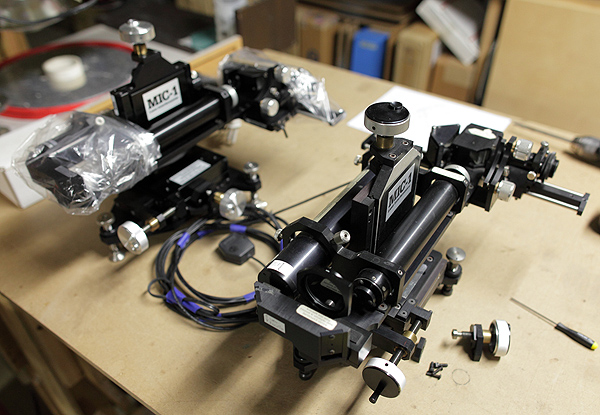 As
the mirror is moved by fractions of a wavelength of light, or millionths of an inch, this "shifts" the phase
of the interferogram, moving the fringes slightly across the image of
the mirror. This is how the method gets its name.
During the phase-shifting, many interferograms are recorded. Then
the software analyzes all of the images, determining the figure of the
mirror to higher resolution and accuracy than static-fringe analysis,
and resolving ambiguities that leave static-fringe analysis algorithms
puzzled and wondering whether a spot is the highest or lowest spot on a
mirror, and what to do with systems of "closed" fringes that are almost unavoidable on mirrors that are even somewhat aspheric.
As
the mirror is moved by fractions of a wavelength of light, or millionths of an inch, this "shifts" the phase
of the interferogram, moving the fringes slightly across the image of
the mirror. This is how the method gets its name.
During the phase-shifting, many interferograms are recorded. Then
the software analyzes all of the images, determining the figure of the
mirror to higher resolution and accuracy than static-fringe analysis,
and resolving ambiguities that leave static-fringe analysis algorithms
puzzled and wondering whether a spot is the highest or lowest spot on a
mirror, and what to do with systems of "closed" fringes that are almost unavoidable on mirrors that are even somewhat aspheric.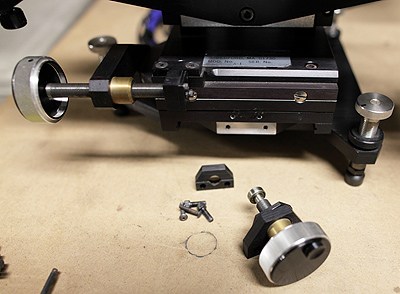 The
other interferometer, seen above on the right of the image will
eventually be used in a dedicated, custom-built flat measuring system
and in other applications where phase shifting is impractical, such as
the low-contrast fringes seen in autocollimation testing of a
Cassegrain telescope with one mirror of the system uncoated.
The
other interferometer, seen above on the right of the image will
eventually be used in a dedicated, custom-built flat measuring system
and in other applications where phase shifting is impractical, such as
the low-contrast fringes seen in autocollimation testing of a
Cassegrain telescope with one mirror of the system uncoated.In the image at right the fine-motion screw of the X-axis has been removed for possible replacement of a worn-out bushing. All axes of adjustment are controlled by these finely machined screws, allowing precise alignment of the interferometer with the return beam.
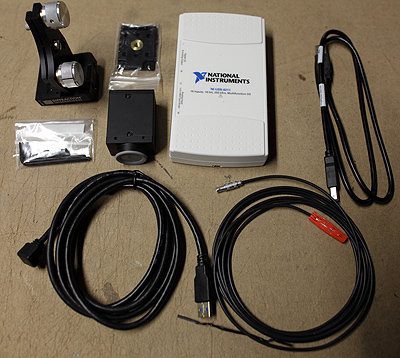
As it turned out, only a cleaning and re-lubrication of the screw and bushing were necessary to return it to good working condition. As with any piece of fine equipment, care in its use and occasional maintenance are not optional.
At left the phase-shifting hardware, new high-resolution digital camera, and various connecting cables are shown. These are added to the stock interferometer to enable the phase shifting to occur. The Durango software takes care of doing all of the work, once properly set up. All of this is run from a laptop with USB 3.0, necessary for all of the data coming from the high-resolution camera.
Phase shifting is useful for just about any measurement, and makes the process of measurement faster, too. Once set up properly, simply click the mouse and a measurement is taken over the course of a few seconds. This is enough to spoil an optician.
 Currently the system is being
used to tweak the figure of revolution of a 45" mirror, which is a
daunting or impossible task without some sort of interferometric
measurement technique at the optician's disposal. Hopefully in
the future the system will be capable of analyzing aspheric mirrors
with fairly good accuracy.
Currently the system is being
used to tweak the figure of revolution of a 45" mirror, which is a
daunting or impossible task without some sort of interferometric
measurement technique at the optician's disposal. Hopefully in
the future the system will be capable of analyzing aspheric mirrors
with fairly good accuracy.However, I must point out at this time and for the forseeable future, Foucault (zonal) testing will be used for the most accurate measurements of the correction (spherical aberration) of a mirror.
It has been a busy winter thus far here at LCO. The stack of mirrors at right is only some of the optics that have been completed recently. Some of that stack goes on to owners and scope builders, and some of them come back to me.
Why do they come back? Some are Cassegrain primaries that are complete, and are ready for coating. Then the coated mirror is used in autocollimation with an uncoated secondary mirror, allowing the tweaking of the system to high accuracy by figuring the secondary mirror to null the system.
In addition to this stack, a number of boxes and crates have headed off to their final destinations all over the world.
I am excited to begin a new phase of optical work here in the shop, with more precision measuring instruments to help ensure the quality of large, fast optics and to assist in testing their cells and holders.
Additionally, special divergers at f/1.8 and f/3.5 were purchased in 2014, allowing analysis of spherical mirrors down to f/0.9 (f/1.8 at radius of curvature) and ultra-fast Cassegrain imaging systems like AG Optical's line of ~f/3.9 imaging Harmer Wynne instruments, the optics for which Lockwood Custom Optics are figuring.
2015 is sure to be another very interesting year, and I hope to keep you informed about it here.
Please check back for future installments of "In the Shop".
Mike Lockwood
Lockwood Custom Optics
